The SMS marketing consumer sentiment report: how your brand can win more customers via text
“You up?”
Everyone knows you’re not supposed to send that text.
But what texts are you supposed to send?
And when? How many?
Text messaging is a genre. And the conventions of any genre need to be learned, even when you’re writing to loved ones you’ve known for years.
For messages coming from ecommerce brands, the bar is even higher.
You have to:
- Entice your people to opt in (no small feat).
- Figure out the right cadence and time of day to contact them.
- Establish trust and connection through what you send them.
- Motivate them to purchase.
- Keep them happy and engaged.
While SMS marketing may be a relatively new phenomenon, brands that understand it—and how it works best—use it to great strategic advantage.
But as more and more brands add SMS marketing as a new channel to their marketing mix, and as consumers get more comfortable receiving text messages from their favorite brands, SMS marketing is becoming like any other marketing channel. That is, it changes—a lot.
What worked last quarter might not for this one—and that’s because consumer expectations change, and often, especially with newer marketing channels.
That’s why we went to the consumers themselves—1,975 of them in the US and Canada, to be exact—to understand how they perceive their relationship with SMS marketing.
We set out with 3 main goals:
- To understand what types of texts consumers want to get and how that varies by what kind of consumer they are
- To determine which brands use SMS and text messaging particularly effectively, and what we can learn from brands that use it less effectively
- To differentiate between SMS messages and emails in terms of how likely they are to drive a consumer to purchase
The consumers we surveyed were all:
- 18 or older
- Living in the US or Canada
- Engaging with brands via SMS
Read on for all the insights we collected about SMS marketing, and how they relate to your brand and your text message marketing program. You’ll learn what you can do to alter your strategy, even slightly, to improve engagement, loyalty—and of course, sales.
Table of contents
- SMS marketing basics: the why, the when, and the what
- How to make SMS subscribers feel seen and connected to your brand
- Why consumers opt in to SMS marketing––and why they opt out
- Subscribing is one thing, but do consumers buy from text messages? Hint: they sure do
- Younger consumers prefer SMS over email, but all age groups are open to texting
- SMS + email: why you need both, not either/or
- Brands that use SMS marketing effectively
SMS marketing basics: the why, the when, and the what
There are some serious benefits to using SMS, if you haven’t gotten started already. In addition to creating better customer experiences through the ability to have two-way conversations, it’s simply a faster way to communicate.
Speed in communication is especially helpful for verticals with higher-value items—if a prospect has a question, they can ask via text and you can respond quickly, giving them the information they need to feel comfortable making the purchase.
Promotional texts message have an average click-through rate of 36%—8x that of email (4.5%).
Unlike email, SMS engagement goes beyond open rates. Promotional texts have an average click-through rate of 36%—8x that of email (4.5%).
So, let’s dig into the nitty-gritty.
How often can you text your customers?
Nearly all survey respondents (96%) reported willingness to receive a text at least once per week. (This is up from 31% in our survey conducted in 2021.)
In general, most shoppers say they prefer to hear from a brand once a week (40%), or a few times a week (30%).
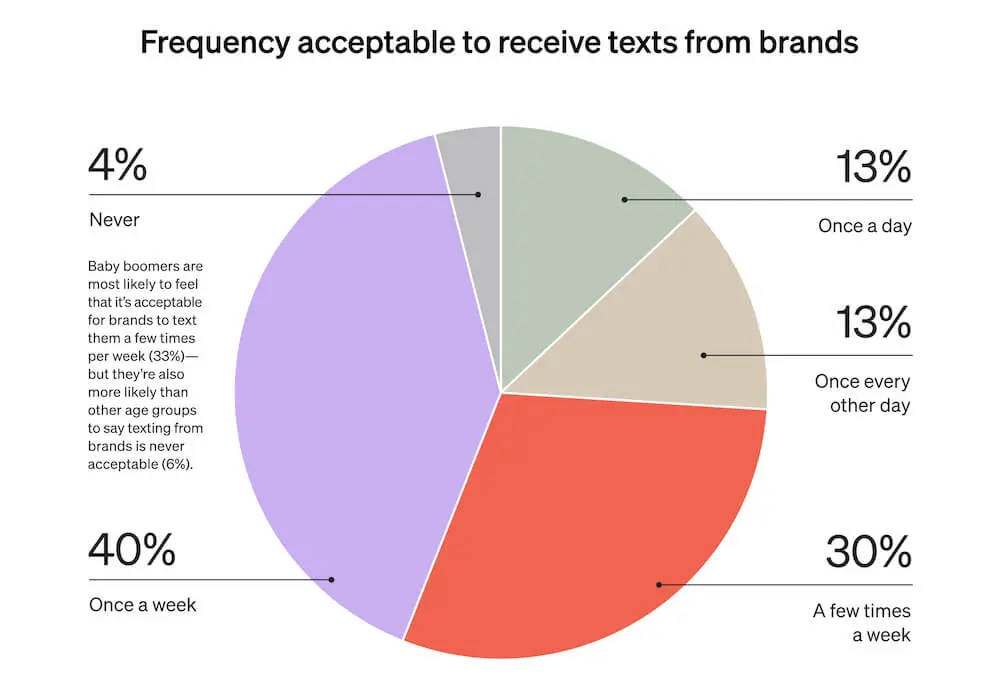
More than twice as many shoppers would rather hear from you via text message than over social media.
This means you’ve got a direct line to your audience—without having to put as much time and effort into conceptualizing social posts.
“When 91% of people are interested in brands reaching out via text, brands should evaluate their program goals and experiment with testing, starting with 5-10 messages per month. Keep in mind that as SMS frequency increases, so will the opt-out rate – especially at 15+ messages per month. Determine how far you can push the envelope without taking a significant hit to engagement and conversion.
An effective way to increase cadence while lowering the risk of list attrition is testing segmented messages based on SMS or website engagement data. By taking an iterative approach to testing, brands can find the sweet spot of meeting business goals while providing valuable content to subscribers.”
What do they want to hear about?
Primarily, SMS subscribers want to receive confirmations, with more than half selecting the following types of messages as preferable:
- Delivery confirmation
- Shipment confirmation
- Order confirmation
Next came coupons and promotional codes, with 30-50% of respondents identifying those types of messages as appropriate and welcome.
The takeaway?
Keep it short, and centered on what they’ve already invested in.
Once they’ve bought something from you, consumers want reassurance and up-to-date information about when they’ll get your product. They want to know that the actions they’ve taken matter, and that everything is going smoothly.

Smaller percentages of folks are up for hearing about back-in-stock notifications, loyalty programs, and other benefits, too.
“Trust and timing are key in eCommerce. Just as the findings show, there are things that customers always want to see—like order confirmations and shipping updates—and some things that they only sometimes want to see, like product promotions and marketing content. To find the sweet spot, you need to know your customers well and form a relationship in which users want to hear from your brand more frequently over time. Our advice? Start with the essentials. Then gradually broach new topics and content types once you’ve gotten to know your customer better.
Texts with a brand should emulate your personal texting habits—there are likely certain people you prefer texting more than others. In the same way, your customers likely prefer hearing from certain brands more than others, regardless of the nature of the text.”
What messages are the most welcome?
Customers reported actually enjoying text messages that are personalized.
For example:
- Discounts personalized according to a consumer’s past purchases
- Offers related to their interests
- Messages about products or services they’ve indicated interest in
This means you’ve got to prioritize personalization. Marketing automation and ecommerce customer data platform (CDP) tools like Klaviyo keep your customer data up to date, making it easier for you to segment users based on their recent purchases and other activity.

With data like this—at your fingertips with Klaviyo’s 260+ integrations—you can send a particular user a personalized message thanking them for their recent review, for example, or offering them a discount on a different wool sweater, similar to the one they just purchased.
Messages that are personalized can feel like they’re coming from someone who knows you, or who is having a conversation with you, which can strengthen rapport, trust, and loyalty.
“We all get dozens of texts each day—your messages need to stand out for recipients to pay attention. People are more likely to act on a text when it looks like you wrote it just for them. This means more than just including basic details like a first name—provide value to your customers by speaking to their unique needs and interests, or by sending exclusive offers aligned with their past purchases
Strategically personalizing your texts helps you nurture relationships with customers by making them feel special. Plus it motivates them to take action immediately.”
What types of messages are folks averse to hearing about via SMS?
In general, respondents are less interested in receiving “interesting” or “helpful” articles via text (49%). For that kind of content, you’re better off sticking to email. (Keep reading to learn what messages work better over email.)
Many (44%) also are not interested in receiving abandoned cart reminders via SMS. (We’ll get to the best way to give them that abandoned-cart nudge later.)
Event SMS announcements are less welcome for a high percentage of people (37%). Save these for your social handles.
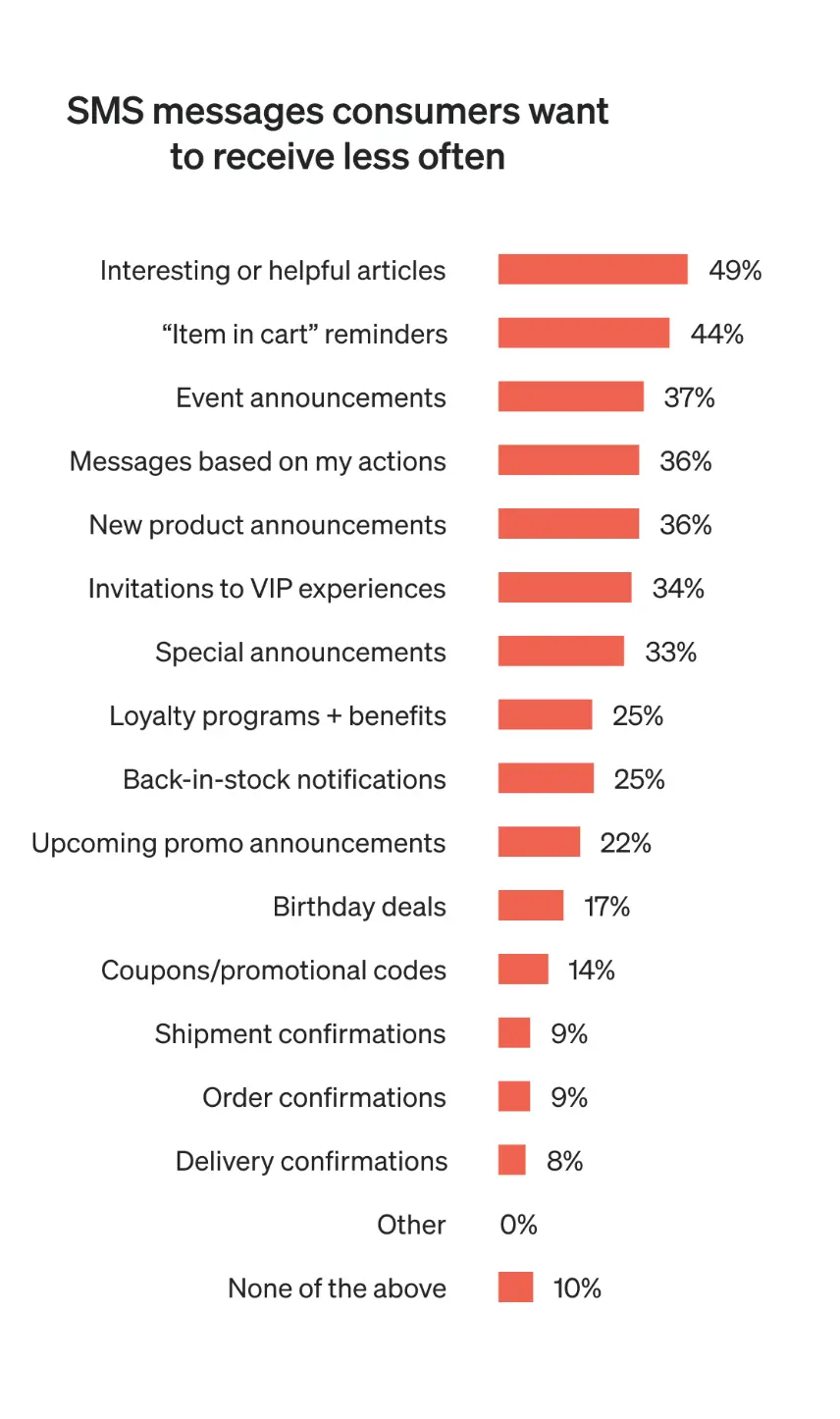
The team at Klaviyo believes consumers are less willing to receive messages about the above because they simply aren’t urgent.
Remember, a text message grabs your consumer’s attention immediately. It goes directly to their phone—their main line of communication with friends and family. Sending a text can be distracting, and consumers prefer those messages from brands be worth that distraction.
“SMS message copy should be as punchy and to the point as possible. You have to quickly convince the customer why they should care, and then immediately draw all of their attention to your CTA. Because of this, content-heavy marketing approaches are better served via the email channel. Email is already known for having a short consumer attention span—and that’s only magnified further on SMS.
For messages you’ll deliver via SMS, follow these tips:
– Use formatting options to provide hierarchy to the SMS “design” and make the content easy to read and understand.
– Use line-breaks to section out content and make the message easily skimmable.
– Lead with a catchy “subject line style” opening phrase to capture attention, especially since this is what the user will see in their push notification.
– Utilize emojis to add personality and draw attention to the CTA link.
– Lastly, try to draw traffic to pages that are low in the funnel, such as a product page. Mobile users have little – patience for navigating through a site from the starting point of the homepage. Get them where they want to go quickly and reduce friction to checkout as much as possible.”
How to make SMS subscribers feel seen and connected to your brand
Given that customers are only willing to subscribe to a handful of brands via SMS (our average respondent subscribes to 2-3), your real estate on their phone screen is valuable.
Our study found that SMS subscribers want to feel like they belong to an exclusive group.
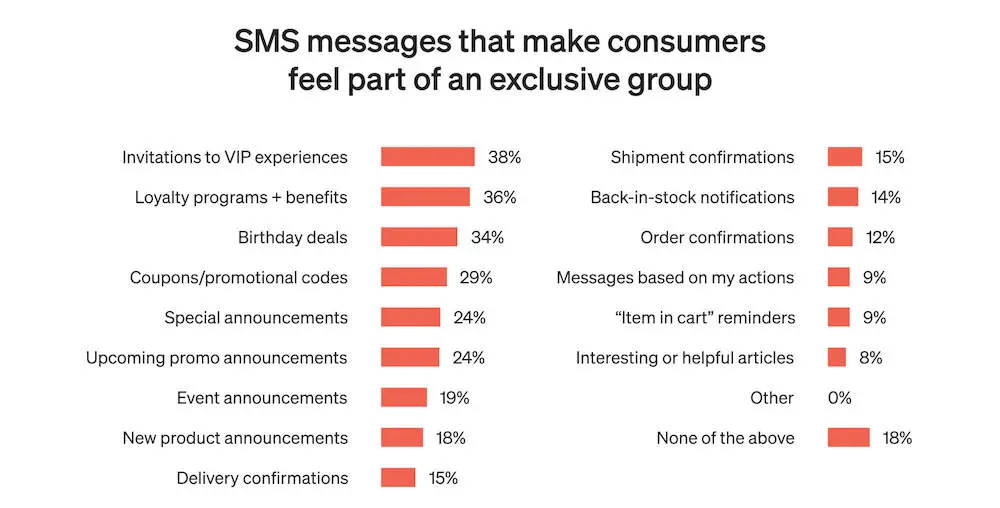
Some ways to make this happen are:
- Inviting them to a VIP experience
- Offering a loyalty program and benefits
- Sending them birthday deals
- Sending them coupons and discounts
- Sending them special announcements

Importantly: About 20% of current SMS subscribers say the texts they get don’t actually make them feel like they’re part of a special group. So, this area is ripe for improvement.
What can you do today to create that special community feeling?
Some tips on using your loyalty program to do it:
- Create a best-in-class customer loyalty program.
- Make sure the benefits are crystal clear to the reader.
- Create a dedicated rewards page that is easy to find (and log in to).
- Offer enough points on the first purchase that it’s worth it to sign up.
Why consumers opt in to SMS marketing––and why they opt out
It may not be tough to get your audience to subscribe to your emails, but the results are in: consumers are pickier about who they give their phone number to.
That’s right—95% of consumers subscribe to less than 7 brands via SMS—considerably fewer brands than most people give their email to.
And it gets even more competitive: about half will only subscribe to 2-3 brands.

So, what makes them opt in to begin with?
Reasons consumers opt in to text message marketing
More than half—51%—of consumers we surveyed opt in to text message marketing if they are about to make a purchase. Slightly more—55%—opt in once they become a frequent shopper, while 51% opt in from a place of love and appreciation for the brand.

How can you get them to opt in if they haven’t already decided to make that first purchase?
50% of shoppers are more likely to subscribe after making a purchase, but a discount can get that needle to move.
According to our survey, nearly 70% of shoppers are willing to subscribe to SMS for a discount.
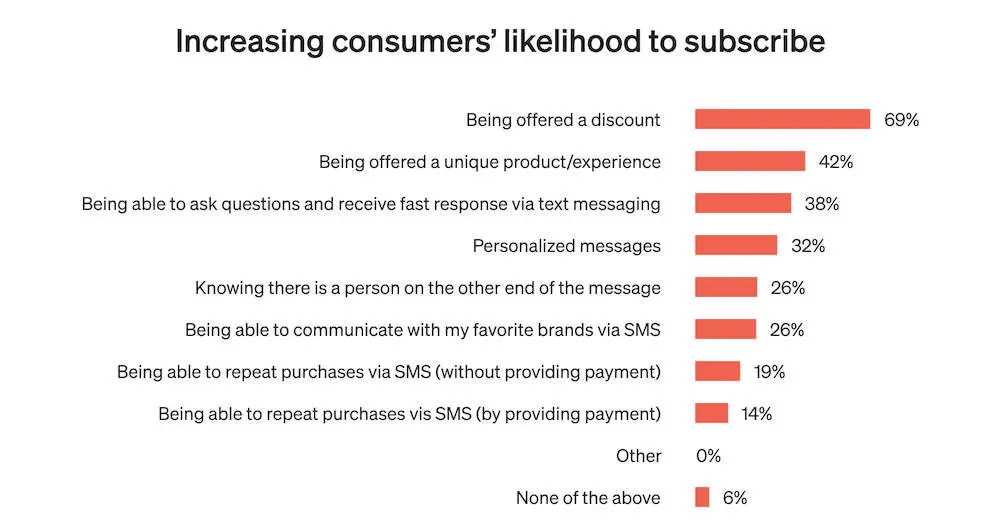
One respondent wrote: “If it has nothing to do with purchase, shipping, or delivery confirmation, then 99.9% of the time the only other reason I would subscribe prior to purchasing would be for a discount of at least 10-15%.”
Others indicated that offers as small as free delivery, insider discounts, and options to continue the subscription would motivate them to subscribe.
“Netflix, YouTube, Amazon. The era of personalization is upon us!
Consumers now expect personalized experiences from their favorite brands. As the data from Klaviyo reveals, most consumers are willing to opt-in to text message marketing from brands they love or if they’re about to make a purchase.
How do you turn these insights into action? Start by using data to create personalized shopping experiences early and often. A tailored experience across the buyer’s journey helps build trust with your shoppers. Most consumers only subscribe to 2-3 SMS programs, so trust in your brand is critical.
– Consider displaying highly-relevant product recommendations in the shopping cart
– Personalize the experience further with data-driven product offers on the home page, the product detail page, and in your post-purchase flows.
– Offer an SMS opt-in option in the shopping cart or a cart flyout like the Rebuy Smart Cart™ (this is an especially powerful tactic).
Today’s consumers are more loyal to brands who offer personalized shopping experiences. So, to win more SMS signups, be the brand they love by giving them the personalized experience they’re hoping for.”
Reasons consumers opt out of text message marketing
Of course, once you’ve gotten someone on your SMS list, you now have to figure out how to keep them there.
This is all about striking a balance between engagement and respect. You don’t want to spam or overload them, and you want to make sure they’re feeling understood by you.
Here are some basic rules for retaining your SMS marketing list:
- Don’t send too many messages.
- Don’t send the same message too many times.
- Be careful to differentiate between what you send via email and SMS—39% of survey respondents said receiving the same message via email and text will make them unsubscribe.

Klaviyo recommends texting a recipient 2-6x a month and sticking to a regular schedule. You’ll also want to create a customer journey (which will be different for a welcome series vs. an abandoned cart, for example).
Finally, you’ll want to send your text messages between 9 a.m. and 8 p.m. in the recipient’s local time zone.
When asked about brands that sent text messages that came across as “spammy” or not worth the read, respondents cited complaints such as messages that were:
- Too frequent
- Too many, and about about the same thing
- About sales that were not worth it
Next, let’s take a look at some brands that do SMS marketing particularly well.
“We like to think of SMS almost as an extension of a loyalty program, where customers are giving us direct communication through the phone in their pocket—something very valuable to the brand. So we want to be respectful of that and share only our most valuable and interesting offers to our SMS subscribers.
In spite of the fact that drafting an SMS message may take less time than composing an email campaign, the same amount of planning should be done. Ask yourself:
– Who should receive this message?
– When should they receive this message?
– Is my message providing value to the customer and not just to my business?
– If my message is going to be shared across both email and SMS, is there a value to the subscriber to get that message via SMS vs email?
– Should they receive the same message and at the same time?�
– What other types of messaging is my customer going to be receiving?
You can often avoid common mistakes that lead to opt-outs by being mindful of the customer, providing value, and planning ahead by asking yourself key questions about the customer journey.”
Subscribing is one thing, but do consumers buy from text messages? Hint: they sure do
Of course, once you begin growing your list, the ultimate goal is to convert subscribers to buyers, and buyers into more frequent buyers.
More good news: 73% of consumers have made a purchase based on receiving a text message from a brand. Over half of them have done this 2-3x.

“Use images or gifs whenever appropriate to show your subscriber why they should engage. Make consideration and purchase a breeze by including a clear CTA and linking the subscriber as far along in the purchase path as possible.”
That’s not all: 24% were motivated by a text message to make a purchase they were not already planning on, while 60% bought earlier than they planned to.

“When a subscriber provides consent for SMS, they have given your brand access to arguably the most personal means of communication. Your message has the opportunity to show up right next to their best friend’s asking about brunch on Sunday.
It is imperative to realize the emotional and monetary value the subscriber’s mobile number holds and treat it as such.”
All because of a text message. Pretty powerful, right?
The No. 1 type of SMS marketing that is likely to convert a subscriber into a buyer is a coupon or promotional code.
However, that isn’t the only kind of message that has the potential to convert. Others include:
- Birthday deals
- Loyalty program offers and benefits
- Confirmations for purchases already made
- Time-sensitive sale announcements
But in general, do consumers sign up for SMS prior to a purchase, or after? After all, with delivery and shipping confirmation SMS messages so beloved, why sign up before? Well, discounts are a driving factor.

“Strategic use of SMS can grow loyalty and customer LTV by increasing the number of or shortening time between purchases. The likelihood of acting upon an SMS reminding you to complete your purchase of that fab new mascara or use your reward dollars before they run out tonight is far greater than that same message buried in dozens of other promo emails in your inbox.”
Younger consumers prefer SMS over email, but all age groups are open to texting
Who you’re texting matters. A lot.
Generation Z (those born between 1997-2012) generally prefers SMS marketing, at least in comparison to other age groups.
Who is Gen Z? Well, they’re worldly even if they haven’t traveled, and they’re often “digital natives”—meaning they learned how to get around the internet as they were learning how to be alive. Most importantly, they’re up for communicating via text. They even prefer it.
After all, while we were all staying home and on our screens during the height of the pandemic, they were, too. And those years, for them, were formative.
So, Gen Z exhibits the highest instance of being able to communicate with brands via SMS. In fact, if they are able to ask a question and get a response via SMS, this increases their likelihood to subscribe.
The flip side is that, in 2021, our survey found them to have the highest number of unread messages on their phones—an average of nearly 100.

In terms of texting with a brand, millennials are a bit different—they like to know whether or not there is a person on the other end of the messages, and they need this to be clear.
Baby boomers, meanwhile, harbor some extreme perspectives on SMS. They’re the generation most likely to be OK with brands texting them several times a week. But more baby boomers than any other generation are also completely closed off to receiving text messages from brands.
In either case, boomers are reading their text messages—as of 2021, they reported an average of only 6 unread messages on their phones.
The good news is if you are collecting birthdays via a form in order to send out birthday deals, you can also segment according to generation, as long as you also collect the year.
SMS + email: why you need both, not either/or
Our study set out to determine the best ways to use SMS in comparison to email—not instead of, but in addition to. The debate between email and SMS creates a false binary: In reality, each channel serves a distinct purpose.
Klaviyo SMS marketing tip:
Understanding consumer expectations around emails vs. texts can help you finetune the different roles email and SMS play in your marketing mix.
Email marketing: keep using it for these types of messages
If it’s not broken, don’t spend a bunch of money and energy trying to fix it.
More than 60% of survey respondents prefer email for hearing about:
- Loyalty program offers and benefits
- Upcoming promotional sales and discount announcements
- New product announcements
- Order confirmations once a purchase is made
- Special announcements
Klaviyo SMS marketing tip:
Each of these messages listed above may feel important to your brand—and of course, you’re excited to share them with your audience. But they don’t necessarily carry the sense of urgency that would warrant the notification and the push to get read in the moment on a consumer’s phone.
Some of these types of messages require additional thinking on the consumer’s part. Or maybe the time of day you sent the message isn’t when they have a moment to browse a new product or sale, so they want to keep the message handy and go back to it when they do have more time.
Emails work better for this, according to consumers themselves.

Here are some helpful questions to think through when deciding if a message should be sent via email or SMS:
- Is this interaction initiated by us (the brand) or the customer? If it’s initiated by you, consider sending it via email.
- How urgent is it? If it’s not urgent, and might require some time for the customer to read or think through, email may be the best channel.
In general, survey respondents didn’t express any reticence at hearing from brands via email, as long as the messages per channel are distinct from each other. In other words, don’t send the same message via both email and SMS.
And remember: Email isn’t a perfect medium. Our survey in 2021 found that the average American had over 1.5K unread emails in their personal inbox. Millennials and Gen Z led the pack with an average of over 2K unread.
“Younger demographics are certainly more open to engaging with brands over SMS, however, we’re starting to see a shift from all consumers in their preference for receiving texts that make their lives more convenient. While I definitely don’t send an email every day, I send a handful of texts per day. The reason is because it’s the fastest and easiest way to communicate. Brands that do text messaging well aren’t just batch-and-blasting sale announcements—they’re making their shoppers’ lives easier by providing things like order updates, replenishment reminders, or shopping assistance, giving their subscribers one less thing to remember or worry about.”
When is email more likely to drive a purchase?
According to our survey, consumers would be more likely to purchase if they received these types of messages via email instead of SMS:
- Articles of interest
- Abandoned cart reminders
- Special announcements
- New product announcements
- Invitations to VIP experiences
- Back-in-stock notifications
In other words, SMS and email should be used jointly. Some consumers prefer email over SMS, and vice versa. Others, still, will likely respond best to a combination of both channels.
And that’s OK! You just need to A/B test, easily allow consumers to update their brand communication preferences, and make sure you respect the desires of different types of consumers as you build out your marketing programs.
Here, see the entire list of messages consumers prefer to receive via email versus SMS.

“Each messaging channel serves a different purpose, and the strategy should be customized to the intended purpose of that channel. For example, SMS is used to create a sense of urgency or a need for immediate action—this channel should not be used to just drive traffic. Users have more control over who can and can’t message them. Irrelevant messages/offers are a surefire way to get unsubscribes or blocked.
A consistent “look and feel” to messages across the right channel mix is KEY. Multi-channel journeys allow us to better engage with users based on their behaviors and actions in a privacy-compliant manner.”
Brands that use SMS marketing effectively
Respondents identified 5 brands whose SMS marketing they approved of:
- Amazon
- Fashion Nova
- Walmart
- Nike
- SHEIN
When asked what about the text messages they liked, the main reason is that the brand only sends messages when necessary.
Respondents appreciate messages that are:
- To the point
- Well-timed
- Informative about discounts and sales
But what if you aren’t one of the leading retailers in the world? Can you still do SMS marketing incredibly well? Absolutely. Let’s look at a few examples.
Take a look at Ivy City Co’s MMS marketing. This text message is to the point and well-timed. The new inventory has just become available. This one also includes a direct link for shopping.
Ivy City Co’s MMS image is also thoughtful. The model exudes happiness, and she looks to be in a beautiful—possibly non-American—city, making the image feel out of the ordinary.
The product itself—the dress—takes up a lot of the image, which is helpful because you can see the important details: the fabric, the cut, the length, and how it fits the model.
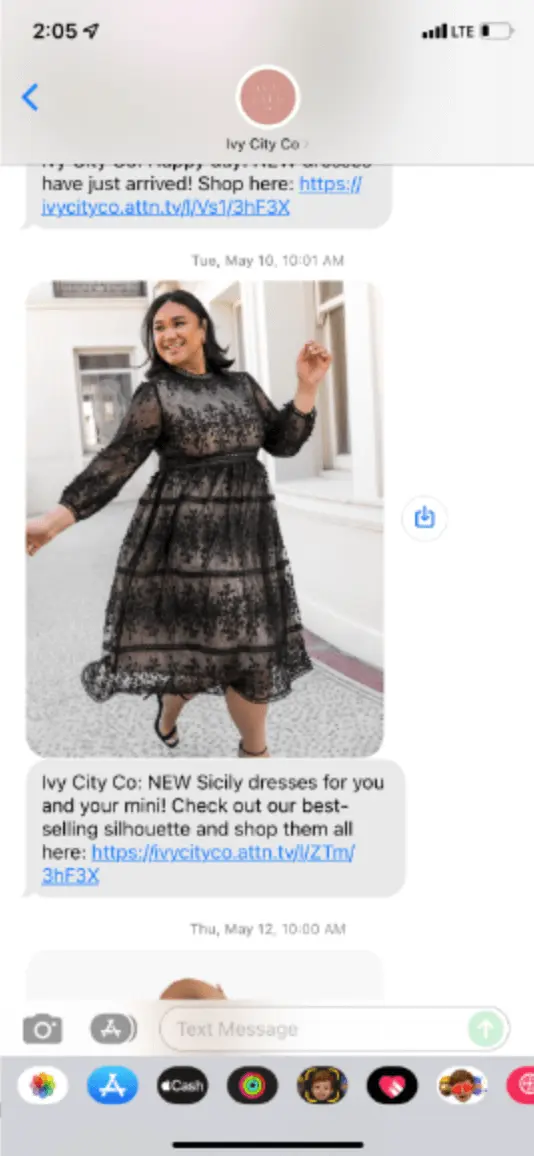
VEGAMOUR’s MMS marketing gets right to the point as well, notifying customers about a sale, telling them how much money they can save, and communicating the products’ benefits, plus the direct link for shopping—pretty impressive for such a short character limit.
VEGAMOUR really makes the most of the image and the space, as well, featuring the product, off-set to the right so that your eye is drawn there. The model’s hair provides the perfect background for the information they want to deliver, and listed in order of importance—exactly how much the customer can save.

You don’t have to use MMS to get SMS marketing right:
Final thoughts
As of our 2021 survey, over a third of Americans reported that their phone is the most important thing they own—and that texting is their primary communication channel, across all generations.
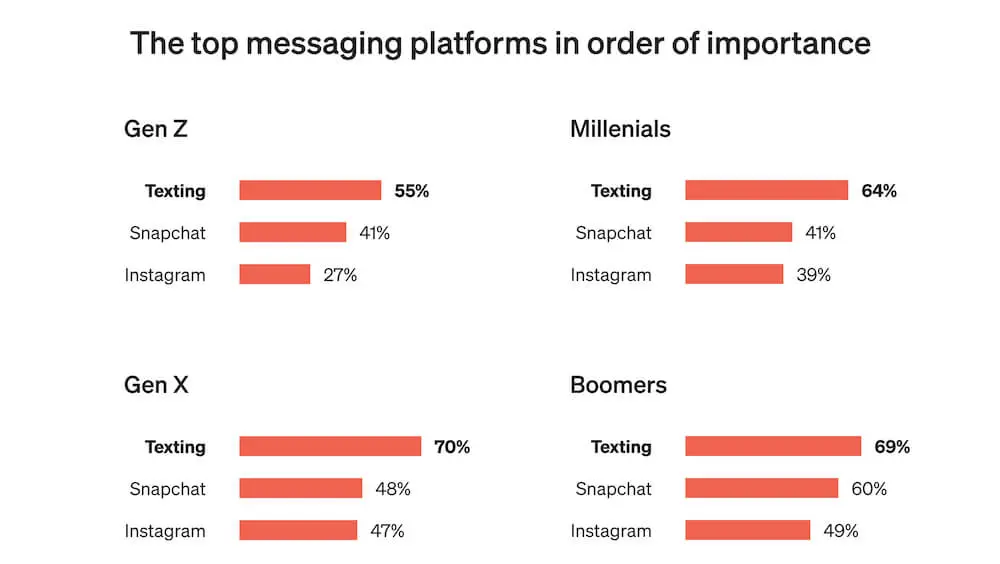
For your brand, SMS marketing makes sense. Most folks in the US and Canada are engaging with text message marketing from brands—though they are pickier than ever about who those messages come from and what they say.
You have to use the real estate you earn on your consumer’s phone as strategically as possible. You need it to convey information important to them. You need it to be urgent. You need it to be a conversation, where possible.
This is where a holistic SMS marketing strategy, including marketing, transactional SMS and two-way SMS messages, comes into play.
No matter how you break it down, SMS marketing is a fast-growing channel consumers like to engage with when it is done right. Your brand can do it right, and make text message marketing a powerful 2023 channel to grow your list, your lifetime loyalty, and your revenue. Klaviyo SMS can get you started.

Related content

Looking for the best SMS marketing tools? See the top 3 platforms for 2026 and learn how to choose the right one for segmentation, automation, and two-way messaging

Marketers are right to be cautious right now. The Texas settlement has sparked more questions than clarity—but that’s exactly why taking a compliance-first approach still matters.
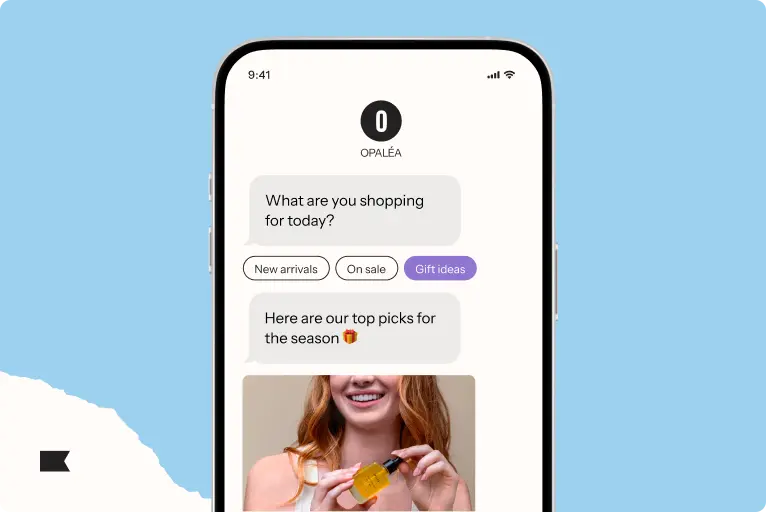
Google’s RCS Roadshow and Klaviyo are shaping the future of mobile marketing with AI-powered personalization and trusted, interactive messaging.